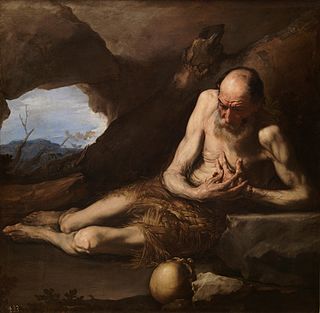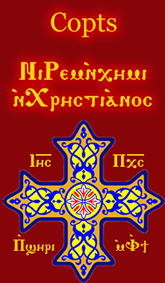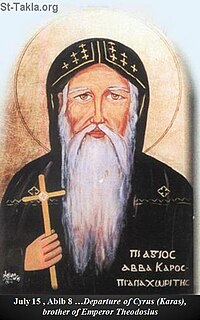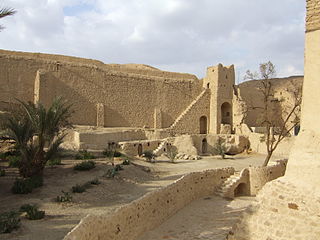
Saint Isaac the Confessor, founder of the Dalmatian Monastery in Constantinople, was a Christian monk who is honored as a saint and confessor. He is sometimes referred to as Isaac the Dalmatian, not because he came from Dalmatia, but because of the monastery which he founded.
Pope Isaac of Alexandria, 41st Pope of Alexandria and Patriarch of the See of St. Mark, was born in El-Borolos from rich, God-fearing parents. They begot him long after their marriage. When they took him for baptism, the bishop who baptized him saw a cross of light over his head. The bishop laid the boy's hand over his head and prophesied concerning him saying, "The church of God will be entrusted to him." Then he told his parents, "Take care of him, for he is a chosen vessel of God."

Pope Cyril V of Alexandria , 112th Pope of Alexandria & Patriarch of the See of St. Mark for 52 years, 9 months and 6 days. He was the longest-serving Pope in the history of the Coptic Orthodox Church. He was born as Youhanna (John) in 1824 or 1830/1831 according to different accounts and he died on 7 August 1927.

Paul of Thebes, commonly known as Paul, the First Hermit or Paul the Anchorite, or in Egyptian Arabic as Anba Bola, Coptic: Ⲁⲃⲃⲁ Ⲡⲁⲩⲗⲉ; is regarded as the first Christian hermit, who was claimed to have lived alone in the desert from the age of sixteen to one hundred thirteen years of his age. He is not to be confused with Paul the Simple, who was a disciple of Anthony the Great. He is venerated as a saint by the Catholic Church as well as the Orthodox Church.

Saint Abram was a contemporary Coptic Orthodox saint. He was the Bishop of Faiyum and Giza, and was also known as the Friend of the Poor.

Pope Macarius III of Alexandria , 114th Pope of Alexandria & Patriarch of the See of St. Mark.

Saint John the Dwarf, also called Saint John Colobus,Saint John Kolobos or Abba John the Dwarf, was an Egyptian Desert Father of the early Christian church.

The Monastery of Saint Macariusthe Great also known as Dayr Aba Maqār is a Coptic Orthodox monastery located in Wadi El Natrun, Beheira Governorate, about 92 km (57 mi) north-west of Cairo, and off the highway between Cairo and Alexandria.

The Coptic Orthodox Church of Alexandria has many churches and congregations in Europe and on 2 June 1974 Pope Shenouda III has received in the Coptic Orthodox Patriarchate of Alexandria a native Orthodox Church in France known as the French Orthodox Eparchy, along with their Primate, who in turn was accepted after consecration into the Episcopate, in the Holy Synod of the Church of Alexandria and hence was appointed their Primate Marcos (Mark), as the first Bishop and Athanasius as Chorbishop of The French Orthodox Eparchy.

The Coptic Orthodox Church of Alexandria has several churches in Great Britain and Ireland, under the jurisdiction of four diocesan bishops.
Abraham of Farshut was an abbot and is a saint of the Coptic Church, and by extension all of the Oriental Orthodox Churches. His feast day in the calendar of saints of the Coptic Church is February 12.

Coptic Monasticism is claimed to be the original form of Monasticism as St. Anthony of Egypt became the first one to be called "monk" and he was the first to established a Christian monastery which is now known as the Monastery of Saint Anthony in the Red Sea area. St. Anthony's Monastery is now the oldest monastery in the world.

Saint Karas the Anchorite, also known as Anbba Karas, was a saint of the Coptic Orthodox Church who lived during the late fifth and early sixth centuries. According to his biographer, the Egyptian monk Saint Pambo, he spent 57 years in isolation in the Scetis Desert in communion with God who visited him every day in his cave. After his death,God closed the cave on his body as the world doesn't deserve his footstep. The location of his cave is unknown.

The Monastery of Saint Paul the Anchorite in Egypt is a Coptic Orthodox monastery located in the Eastern Desert, near the Red Sea Mountains. It is about 155 km (96 mi) south east of Cairo. The monastery is also known as the Monastery of the Tigers.
Saint Thomas the Hermit is a Saint of the Coptic Orthodox Church, he is also known as "Saint Thomas the Anchorite", "Saint Thomas of Shenshif" or simply as "Abba Thomas"[(Coptic word meaning Father) (Αw-ba)Sahidic (Αw-va)Bohairic]. Saint Thomas was born in Upper Egypt, in a small village known as "Shenshif". He is revered by the Coptic Orthodox Church, since he is one of the early Anchorites, or Desert Fathers. Little is commonly known about him.

Monastery of Saint Samuel the Confessor, Dair al-Anba Ṣamū'īl al-mu'tarif " or Deir el-Qalamun is an Egyptian monastery in the western desert.
Anba Epiphanius was an Egyptian Coptic Orthodox Church bishop. He was appointed as the bishop and abbot of the Monastery of St. Macarius in 2013, a position he held until his death on July 29, 2018.











